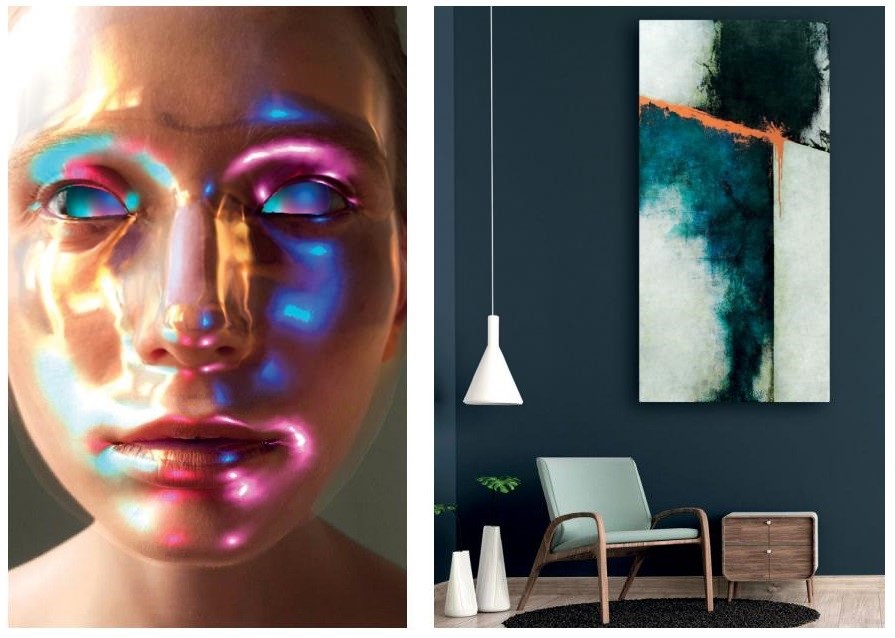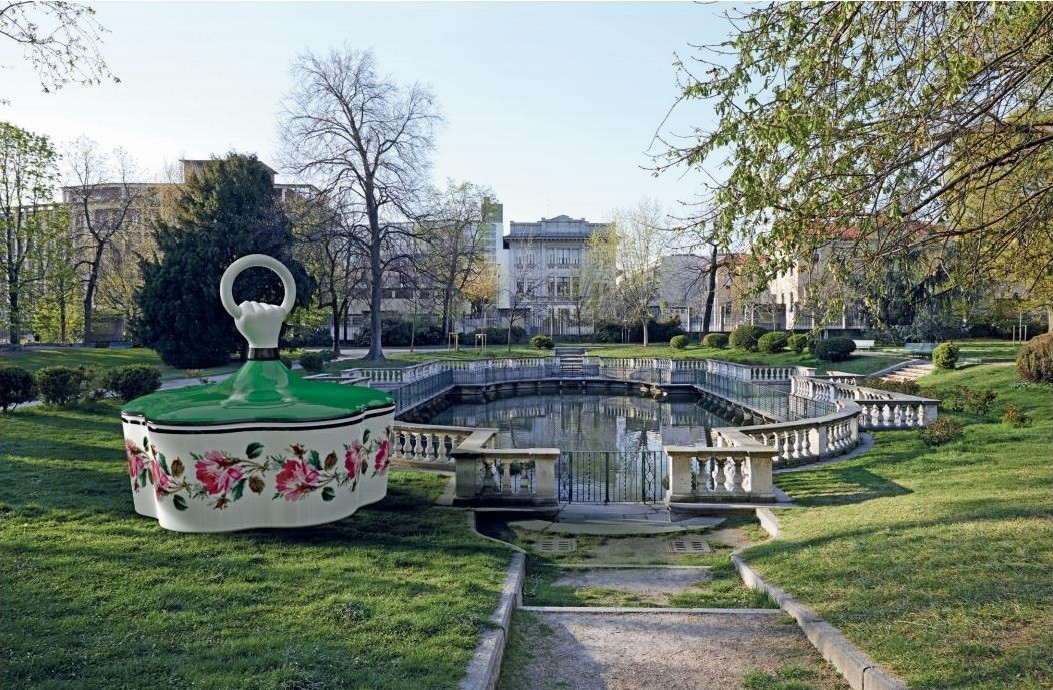Augmented reality is opening up vast new possibilities to how people access and consume fashion, design and lifestyle. Keng Yang Shuen reports on how the technology is increasingly giving everyone a chance to get a front row experience – and more.




Opposite, clockwise from top left: A selfie augmented with the cyborg-esque face filter Beauty3000, an example of everyday AR technology that creatives are increasingly using to make a statement about identity; online gallery The Artling’s AR feature allows one to visualise how a work would look like in a space; and a photo taken with Gucci’s AR-friendly app, updated in conjunction with April’s Milan Design Week to let users superimpose furniture from the brand’s homeware line onto specific historical sites across the city.
The date: March 3, 2006. The fashion cognoscenti that had descended into Paris’ Palais Omnisports de Paris-Bercy stadium was just letting the visual spectacle of Alexander McQueen’s Widows of Culloden show – wholly feathered gowns, lace-swathed antler headdresses – sink in when the runway lights dimmed. Suddenly, from amid the darkness, a plume of smoke appeared, only to unfurl into a holographic vision of Kate Moss in a billowing chiffon gown, dancing languidly in mid-air like some celestial apparition to the melancholic soundtrack of Schindler’s List.
Co-created by the late McQueen and filmmaker Baillie Walsh, the emotive sight remains one of the earliest and most famous examples of augmented reality (AR) to come from the fashion world. (The rapper Tupac would be resurrected to perform at Coachella in a reportedly similar way – 15 years after his murder – only in 2012.)
These days, the term AR – first coined in the ’90s – might still sound like something out of a Wachowskis movie. How, when and by whom it’s used has, however, become far less mystifying. Ever played a round of Pokemon Go? The billion-dollar grossing app (make that two billion as of 2019, actually) is usually cited as today’s prime example of AR – or tech that superimposes digital images onto a user’s view of the real world, according to the Oxford English Dictionary.
It’s not to be confused with virtual reality, or VR, which immerses users into a completely simulated environment, and typically requires dedicated equipment such as a specialised headset (think Facebook’s Oculus Rift). That a smartphone is all that one needs to access some mode of AR has essentially democratised the technology, and this has only brought about a wealth of possibilities that creative industries have tapped to transform the consumer experience.
Around the same time two years ago, Instagram debuted selfie filters on its Stories function (yup, those add-on kitten ears or shower of golden glitter? All AR). Burberry, too, launched an AR feature on its eponymous app. A collaboration with the irreverent, street-inspired British artist Danny Sangra, it allowed users to “enhance” their photos with Burberry-inspired illustrations before hitting “Share” on social media.
The idea is nowhere as exclusive as seeing the technologically created spectre of a supermodel materialise out of thin air at Fashion Week, but one can’t discount the novelty or creativity. Since then, brands ranging from Off-White to Dior have introduced similar features on Instagram with an added practical touch. The former’s lets one virtually try on its popular neon sunnies, while the Dior Kaleidescope filter – launched this March – superimposes onto selfies the brand’s Diorsolight shades or dance-inspired headbands from Spring/Summer 2019.
According to Apple CEO Tim Cook in an interview with Vogue UK, AR is still an emerging field for fashion retailers looking to virtually attire a customer, as the tech to motion track one’s frame accurately is not advanced enough. While brands figure this out, some are applying the tech to items beyond clothes and accessories.
Following its AR-fitted Spring/Summer 2018 ad campaign that viewers could scan and animate with 3D effects, Gucci expanded its app offering two months ago to cover its homeware line. Through it, users can virtually place Gucci Decor furniture into various spaces to envision how they would fit before buying.

The haunting hologram of Kate Moss that closed Alexander McQueen’s Widows of Culloden Fall/Winter 2006 show, one of the earliest and most famous uses of AR in fashion
Photo tpgimages.com
It’s a nifty idea that’s also been recently adopted at the Singapore-based art and design gallery The Artling. Says the online outfit’s director Kim Tay: “One of the main challenges faced by customers looking to buy art online is that it is difficult to visualise the size and scale of works in their space. The AR feature directly addresses this, making buying art online easier than ever.”
This ability to let consumers get a fun, firsthand experience of a product without the investment has driven beauty labels in particular to embrace AR. Follow Kylie Jenner on Instagram to unlock a special face filter that allows seven of Kylie Cosmetics’ best-selling lip colours to be digitally applied onto your face to see if it suits your skin tone. And to prove just how big business such features can mean: L’Oreal acquired beauty AR specialist company Modiface last year in a bid to beef up its AR game.
Beyond encouraging informed consumerism though, AR has become a tool for creatives to disrupt existing notions of beauty. Beauty3000, an Instagram filter created by Berlin-based artist Johanna Jaskowska, adds an Ex Machina-esque pearlescent sheen to selfies. It went viral in January, thanks to plenty of high-profile users such as model Jazzelle Zanaughtti, aka Uglyworldwide, who’s known for her unconventional good looks, and catapulted Jaskowska from nobody to Insta-star with more than 650K followers in four months. How to get it? Follow her account @johwska and the filter will automatically appear on your Stories feature.
The 26-year-old is far from the only “alt” face filter creator. In 2019, such AR-backed effects are increasingly favouring the weird and even trans-human. Other notable creators include Aaron Jablonski (@exitsimulation) and typically whip up portraits with futuristic elements such as computer glitches (the filter’s aptly named “Glitch”), or create spectral clones (this one’s called “Monologue”). Just like that, what was once the realm of Hollywood can now be simulated right on one’s phone – say goodbye to those basic dog ears from the Snapchat era.
In an interview with Dazed Digital, Jaskowska says she’s not interested to make one look, say, Kardashian-esque. “Beauty on social media has become boring. I’m not making filters to follow what has already been done. I want to experiment and provoke.” Here AR doesn’t so much provide one special access as it does the power to craft out an identity and make a statement.
Is AR going to be bigger? Possibly – many brands, including global titans Google and Apple, are investing heavily into it, with the latter rumoured to be working on its own AR glasses. As its CEO Cook points out: “I don’t think there is any sector or industry that will be untouched by AR.”
It’s also hard to deny its democratising effect. If one’s proximity to the action is indeed telling of one’s social status, then AR offers practically anyone with a smartphone a front row ticket. In March, the London College of Fashion partnered with AR specialist Holome to put on a live AR stream of its MA graduate show. The technology allowed users to view the presentation through their phones and make it seem as if it was happening right in front of them, superimposing the models onto any background.
And taking its Tupac hologram experiment to a whole new level, the latest edition of Coachella in April included an “immersive stage experience” at its Sahara tent. While acts like Diplo and Kid Cudi performed, festival goers could turn on the Coachella app to generate audio-sensitive filters in the form of astronauts, asteroids and the like. How’s that for an out of this world time?
PHOTOGRAPHY VEE CHIN STYLING IMRAN JALAL HAIR CHRISTVIAN,
USING REVLON PROFESSIONAL MAKEUP WEE MING, USING SHU UEMURA MODEL LIZA V/LOOQUE DRESS & BOOTS GIVENCHY























